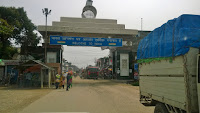 Every effort had been made to get
regular updates of the situation prevailing in Nepal.The eleventh day of the
Trans Himalayan Expedition was no exception. Mohan, previously of Container
Corporation of India, had been giving me information regularly about the
condition in Nepal. Unfortunately, there was nothing much to cheer about. I had
already made major diversions based on the deteriorating law and order
condition in that country. An entry into Nepal via Sonauli and Behaliya was my
last hope of driving through Nepal. Accordingly, I set course from Lucknow in
the morning.
Every effort had been made to get
regular updates of the situation prevailing in Nepal.The eleventh day of the
Trans Himalayan Expedition was no exception. Mohan, previously of Container
Corporation of India, had been giving me information regularly about the
condition in Nepal. Unfortunately, there was nothing much to cheer about. I had
already made major diversions based on the deteriorating law and order
condition in that country. An entry into Nepal via Sonauli and Behaliya was my
last hope of driving through Nepal. Accordingly, I set course from Lucknow in
the morning. During the day I covered over 450 km
of which the 280 km between Lucknow and Gorakhpur was a beauty. It needed less
than 4 hours of easy driving. The 100 km stretch from Gorakhpur to Sonauli, the
Indian side of the border, is badly maintained, congested and misused by errant
driving. One of the motorized carts veered close to the car and damaged the
left side view mirror. Without the side view mirror driving became a nightmare
on crowded roads.
During the day I covered over 450 km
of which the 280 km between Lucknow and Gorakhpur was a beauty. It needed less
than 4 hours of easy driving. The 100 km stretch from Gorakhpur to Sonauli, the
Indian side of the border, is badly maintained, congested and misused by errant
driving. One of the motorized carts veered close to the car and damaged the
left side view mirror. Without the side view mirror driving became a nightmare
on crowded roads. Mohan had arranged for the Behaliya
ICD in charge, Ravi, to meet me on the Indian side. I parked the car, met up
with Ravi and went to the Customs post, where friendly customs officials
chatted for a while and told me that I would not have to fill in any papers
there. They also told me to get back to them for lunch in case I would not be
going further into Nepal. The volatile situation inside Nepal had prevented
smooth
Mohan had arranged for the Behaliya
ICD in charge, Ravi, to meet me on the Indian side. I parked the car, met up
with Ravi and went to the Customs post, where friendly customs officials
chatted for a while and told me that I would not have to fill in any papers
there. They also told me to get back to them for lunch in case I would not be
going further into Nepal. The volatile situation inside Nepal had prevented
smooth  After spending a lot of time getting
to the ‘bottom of things’ I returned to the India border post. I decided to
take up the offer for lunch. And what a lovely time I had with them and Ravi.
Over lively conversation about the service and living conditions there I was
made to feel absolutely at home. Most of those who were deputed to the outpost
had their families in faraway places. Bonhomie amongst such persons is very
different than in the ‘family stations’. After a leisurely lunch that almost
stretched up to tea time I retraced my drive to Gorakhpur and sought refuge in
the railway rest house at the station. Indeed I was disappointed that the Nepal
leg of the expedition has been scuttled due to escalating political violence.
After spending a lot of time getting
to the ‘bottom of things’ I returned to the India border post. I decided to
take up the offer for lunch. And what a lovely time I had with them and Ravi.
Over lively conversation about the service and living conditions there I was
made to feel absolutely at home. Most of those who were deputed to the outpost
had their families in faraway places. Bonhomie amongst such persons is very
different than in the ‘family stations’. After a leisurely lunch that almost
stretched up to tea time I retraced my drive to Gorakhpur and sought refuge in
the railway rest house at the station. Indeed I was disappointed that the Nepal
leg of the expedition has been scuttled due to escalating political violence.
I was quite worried about the safety of the car in
the parking lot at the Gorakhpur railway station. However, the person in charge
of the parking lot showed me to a secure area and assured me that the car would
be safe there. The ORH at the station is a far cry from the ORH near the
railway headquarter office. But this was good enough for a short stay that was
arranged at the eleventh hour, to say the least. Gorakhpur, on the banks of the
River Rapti, is an administrative town. But it is also home to many historic
temples like the Gorakhnath temple and has many important Hindu and Buddhist
sites. Kabir, the 15th century mystic poet, is buried in Maghar,
which is also near Gorakhpur.








Loved the detailed travel experience! Such road trips become more comfortable when you Hire Tempo Traveller in Lucknow for group journeys through scenic and offbeat destinations like these.
ReplyDelete